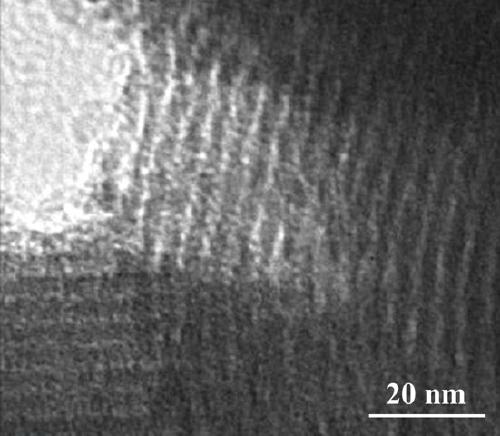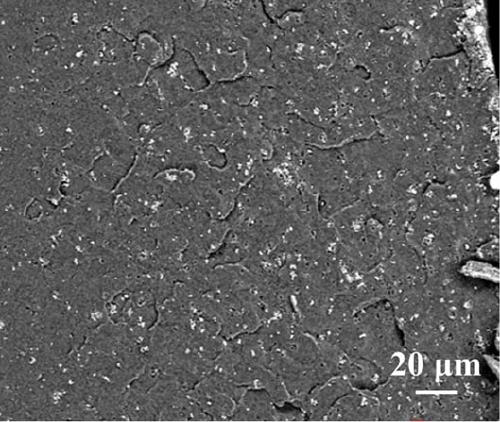Preparation of polyester/periodic mesoporous bone-filling composite material with fluorescently-labeled degradation rate, product and application
A fluorescent labeling and degradation rate technology, used in medical science, tissue regeneration, prostheses, etc., can solve problems such as the inability to directly observe the degradation rate and the rate of bone healing, the mismatch of mechanical properties of natural bone, and the uncontrollable degradation time. , to increase the compatibility of the organic-inorganic interface, overcome the decline of material properties, and improve the luminous efficiency and stability.
- Summary
- Abstract
- Description
- Claims
- Application Information
AI Technical Summary
Problems solved by technology
Method used
Image
Examples
Embodiment 1
[0039] A method for preparing a polyester / periodic mesoporous bone-filling composite material whose degradation rate can be fluorescently marked. The biodegradable polylactic acid-based random copolymer is used as the matrix, and the modified rare earth periodic mesoporous fluorescent material is used as the matrix. An enhancer and a fluorescent agent are used to prepare a composite material with self-enhancement effect and degradation rate that can be fluorescently marked, including the following steps:
[0040] 1) Preparation of rare earth periodic mesoporous nanoparticles with fluorescent properties:
[0041] First, carry out amination modification on rare earth complexes: add 20 mL THF solvent into a three-necked flask, then add 2 mmol 0.5366 g N,N'-bis(salicylidene)ethylenediamine (Salen), and wait until it is completely dissolved Add 4 mmol 1.0 g triethoxysilyl isopropyl isocyanate (TEPIC), condense and reflux for 12 h under the protection of nitrogen at 65 °C, and final...
Embodiment 2
[0051] Approximate with embodiment 1 step, comprise the following steps:
[0052] 1) Preparation of rare earth periodic mesoporous nanoparticles with fluorescent properties:
[0053]First, carry out amination modification on rare earth complexes: add 20 mL THF solvent into a three-necked flask, then add 2 mmol 0.5366 g N,N'-bis(salicylidene)ethylenediamine (Salen), and wait until it is completely dissolved Add 4 mmol 1.0 g triethoxysilyl isopropyl isocyanate (TEPIC), condense and reflux for 12 h under the protection of nitrogen at 65 °C, and finally separate and purify the obtained solution by a rotary evaporator to obtain a light yellow viscous The liquid is denoted as Salen-Si; secondly, in situ synthesis of periodic mesoporous graft complex composites: the template agent cetyltrimethylammonium bromide (CTAB) (0.416 g) and NaOH (0.1888 g) were dissolved in de Ionized water (12.72 mL), then a mixed solution of Salen-Si and 1,2-bis(triethoxysilyl)ethane (BTEE) (0.72 mL) was b...
Embodiment 3
[0061] Approximate with embodiment 1 step, comprise the following steps:
[0062] 1) Preparation of rare earth periodic mesoporous nanoparticles with fluorescent properties:
[0063] First, carry out amination modification on the rare earth complex: add 20 ml tetrahydrofuran solvent into a three-necked flask, then add 2 mmol 0.5366 g N,N'-bis(salicylidene)ethylenediamine (Salen), and wait until it is completely dissolved Add 4 mmol 1.0 g triethoxysilyl isopropyl isocyanate (TEPIC), condense and reflux for 12 h under the protection of nitrogen at 65 °C, and finally separate and purify the obtained solution by a rotary evaporator to obtain a light yellow viscous The liquid is denoted as Salen-Si; secondly, in situ synthesis of periodic mesoporous graft complex composites: the template agent cetyltrimethylammonium bromide (CTAB) (0.416 g) and NaOH (0.1888 g) were dissolved in de Ionized water (12.72 mL), then a mixed solution of Salen-Si and 1,2-bis(triethoxysilyl)ethane (BTEE) ...
PUM
 Login to View More
Login to View More Abstract
Description
Claims
Application Information
 Login to View More
Login to View More - R&D
- Intellectual Property
- Life Sciences
- Materials
- Tech Scout
- Unparalleled Data Quality
- Higher Quality Content
- 60% Fewer Hallucinations
Browse by: Latest US Patents, China's latest patents, Technical Efficacy Thesaurus, Application Domain, Technology Topic, Popular Technical Reports.
© 2025 PatSnap. All rights reserved.Legal|Privacy policy|Modern Slavery Act Transparency Statement|Sitemap|About US| Contact US: help@patsnap.com



